2005 Hyundai Terracan checking oil
[x] Cancel search: checking oilPage 223 of 539
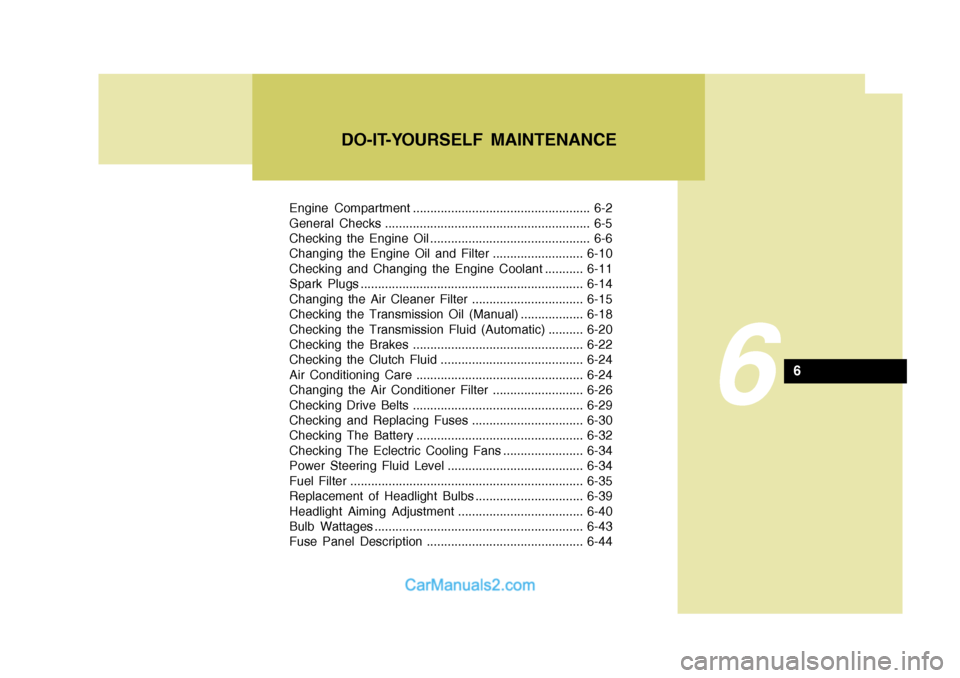
Engine Compartment ................................................... 6-2
General Checks ........................................................... 6-5
Checking the Engine Oil .............................................. 6-6
Changing the Engine Oil and Filter ..........................6-10
Checking and Changing the Engine Coolant ........... 6-11
Spark Plugs ................................................................ 6-14
Changing the Air Cleaner Filter ................................ 6-15
Checking the Transmission Oil (Manual) .................. 6-18
Checking the Transmission Fluid (Automatic) .......... 6-20
Checking the Brakes ................................................. 6-22
Checking the Clutch Fluid ......................................... 6-24
Air Conditioning Care ................................................ 6-24
Changing the Air Conditioner Filter .......................... 6-26
Checking Drive Belts ................................................. 6-29
Checking and Replacing Fuses ................................ 6-30
Checking The Battery ................................................ 6-32
Checking The Eclectric Cooling Fans ....................... 6-34
Power Steering Fluid Level ....................................... 6-34
Fuel Filter ................................................................... 6-35
Replacement of Headlight Bulbs ............................... 6-39
Headlight Aiming Adjustment .................................... 6-40
Bulb Wattages ............................................................ 6-43
Fuse Panel Description ............................................. 6-44
DO-IT-YOURSELF MAINTENANCE
6
6
Page 228 of 539
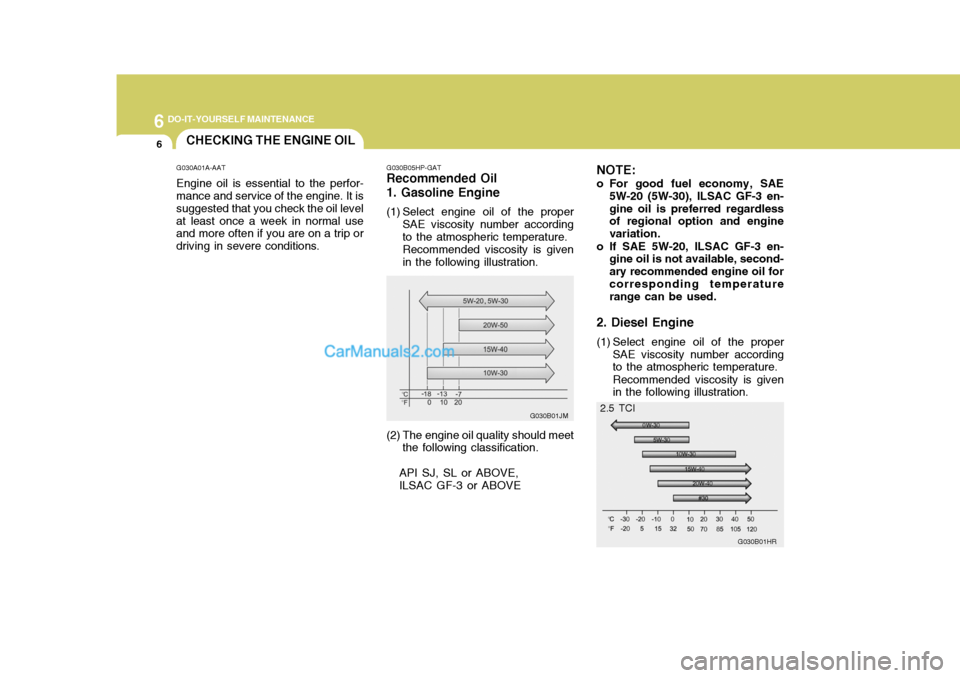
6 DO-IT-YOURSELF MAINTENANCE
6CHECKING THE ENGINE OIL
G030A01A-AAT Engine oil is essential to the perfor- mance and service of the engine. It is suggested that you check the oil levelat least once a week in normal use and more often if you are on a trip or driving in severe conditions. G030B05HP-GAT
Recommended Oil 1. Gasoline Engine
(1) Select engine oil of the proper
SAE viscosity number according to the atmospheric temperature. Recommended viscosity is given in the following illustration.
(2) The engine oil quality should meet the following classification.
API SJ, SL or ABOVE, ILSAC GF-3 or ABOVE NOTE:
o For good fuel economy, SAE 5W-20 (5W-30), ILSAC GF-3 en- gine oil is preferred regardless of regional option and engine variation.
o If SAE 5W-20, ILSAC GF-3 en- gine oil is not available, second-ary recommended engine oil forcorresponding temperature range can be used.
2. Diesel Engine
(1) Select engine oil of the proper SAE viscosity number according to the atmospheric temperature. Recommended viscosity is given in the following illustration.
G030B01JM
G030B01HR
2.5 TCI
Page 229 of 539
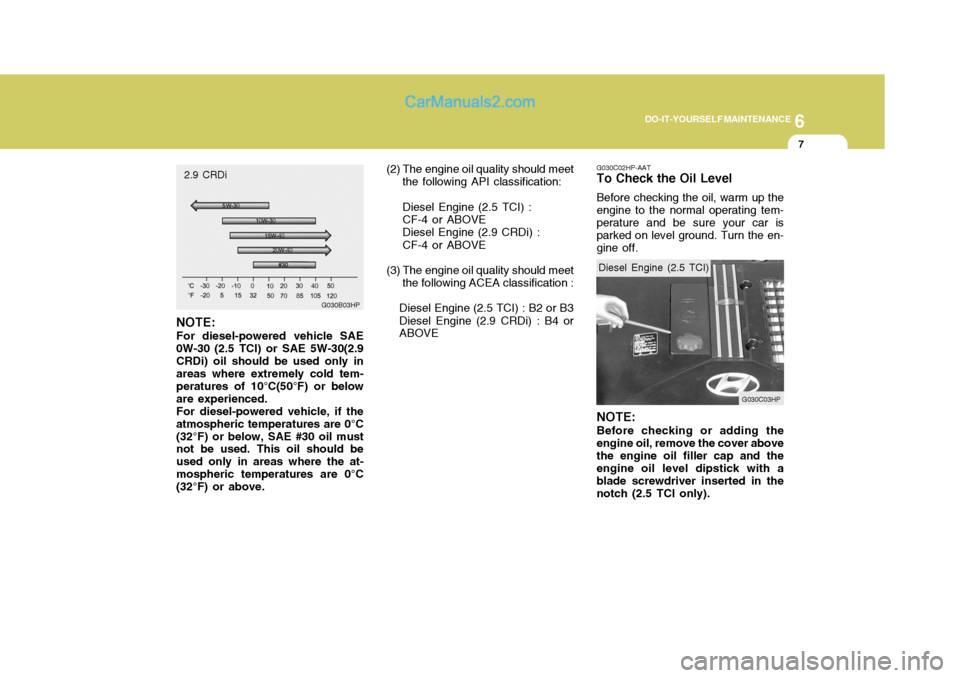
6
DO-IT-YOURSELF MAINTENANCE
7
NOTE: For diesel-powered vehicle SAE 0W-30 (2.5 TCI) or SAE 5W-30(2.9CRDi) oil should be used only in areas where extremely cold tem- peratures of 10°C(50°F) or beloware experienced.For diesel-powered vehicle, if theatmospheric temperatures are 0°C(32°F) or below, SAE #30 oil must not be used. This oil should be used only in areas where the at-mospheric temperatures are 0°C (32°F) or above. (2) The engine oil quality should meet
the following API classification: Diesel Engine (2.5 TCI) : CF-4 or ABOVE Diesel Engine (2.9 CRDi) : CF-4 or ABOVE
(3) The engine oil quality should meet the following ACEA classification :
Diesel Engine (2.5 TCI) : B2 or B3Diesel Engine (2.9 CRDi) : B4 or ABOVE G030C02HP-AAT To Check the Oil Level Before checking the oil, warm up the engine to the normal operating tem- perature and be sure your car is parked on level ground. Turn the en-gine off. NOTE: Before checking or adding the engine oil, remove the cover abovethe engine oil filler cap and the engine oil level dipstick with a blade screwdriver inserted in thenotch (2.5 TCI only).
G030B03HP
G030C03HP
2.9 CRDi
Diesel Engine (2.5 TCI)
Page 230 of 539
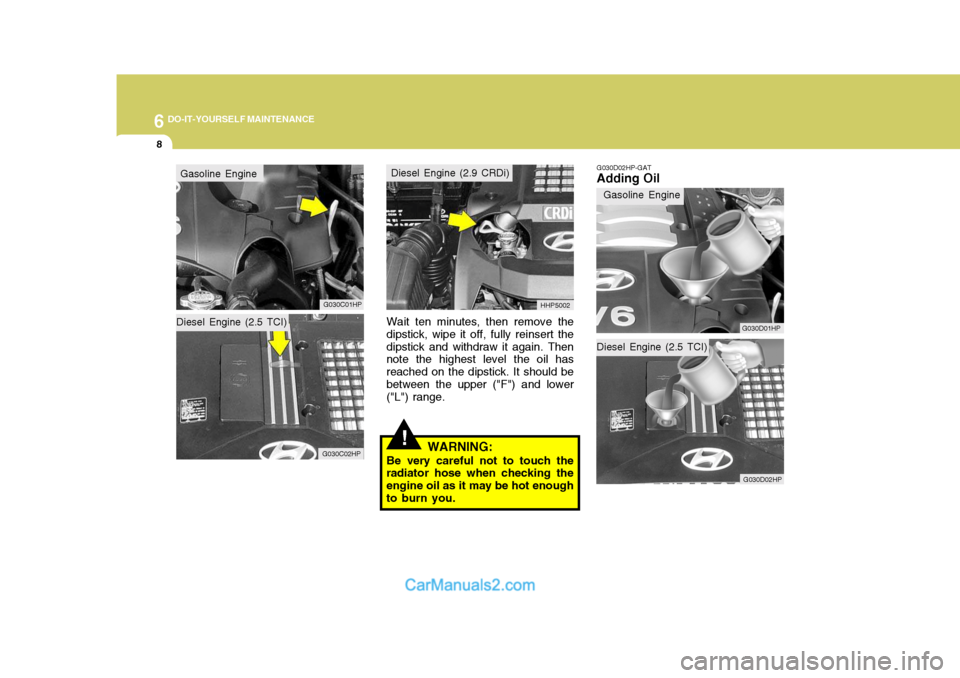
6 DO-IT-YOURSELF MAINTENANCE
8
Diesel Engine (2.5 TCI)
Wait ten minutes, then remove the dipstick, wipe it off, fully reinsert thedipstick and withdraw it again. Then note the highest level the oil has reached on the dipstick. It should bebetween the upper ("F") and lower ("L") range.
Diesel Engine (2.5 TCI) G030D02HP-GAT
Adding Oil
HHP5002
G030C02HP
Gasoline Engine
Diesel Engine (2.9 CRDi)
G030D01HPG030D02HP
Gasoline Engine
!WARNING:
Be very careful not to touch the
radiator hose when checking the engine oil as it may be hot enoughto burn you.
G030C01HP
Page 233 of 539
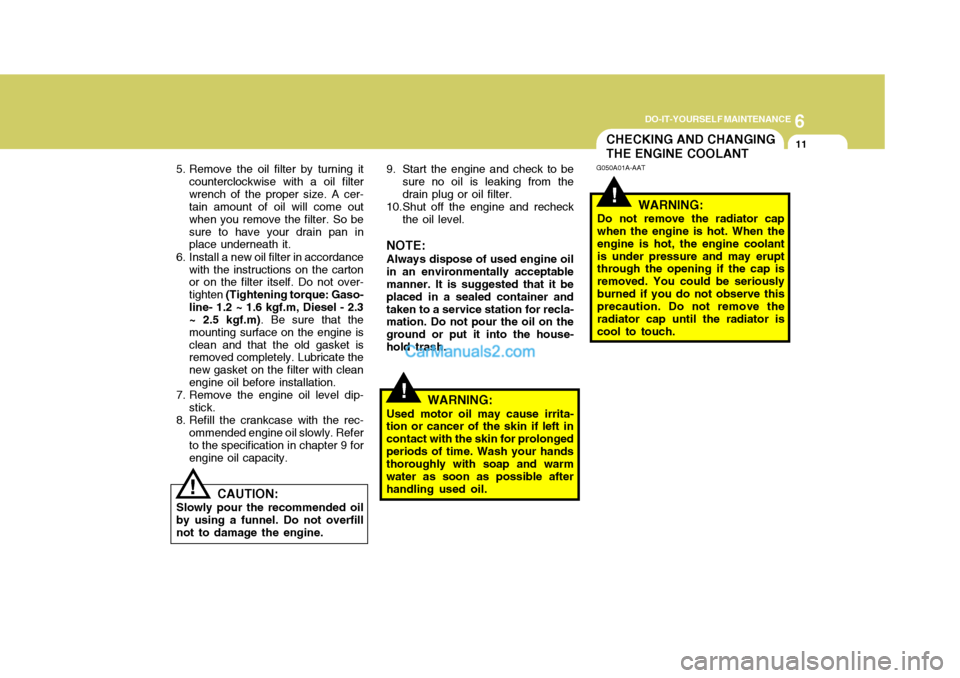
6
DO-IT-YOURSELF MAINTENANCE
11CHECKING AND CHANGING THE ENGINE COOLANT
!
G050A01A-AAT
WARNING:
Do not remove the radiator cap when the engine is hot. When the engine is hot, the engine coolantis under pressure and may erupt through the opening if the cap is removed. You could be seriouslyburned if you do not observe this precaution. Do not remove the radiator cap until the radiator iscool to touch.
!
5. Remove the oil filter by turning it counterclockwise with a oil filter wrench of the proper size. A cer- tain amount of oil will come out when you remove the filter. So besure to have your drain pan in place underneath it.
6. Install a new oil filter in accordance with the instructions on the cartonor on the filter itself. Do not over- tighten (Tightening torque: Gaso-
line- 1.2 ~ 1.6 kgf.m, Diesel - 2.3 ~ 2.5 kgf.m) . Be sure that the
mounting surface on the engine is clean and that the old gasket is removed completely. Lubricate the new gasket on the filter with cleanengine oil before installation.
7. Remove the engine oil level dip- stick.
8. Refill the crankcase with the rec- ommended engine oil slowly. Referto the specification in chapter 9 for engine oil capacity.
! CAUTION:
Slowly pour the recommended oil by using a funnel. Do not overfill not to damage the engine. 9. Start the engine and check to be
sure no oil is leaking from thedrain plug or oil filter.
10.Shut off the engine and recheck
the oil level.
NOTE: Always dispose of used engine oil
in an environmentally acceptable manner. It is suggested that it be placed in a sealed container andtaken to a service station for recla- mation. Do not pour the oil on the ground or put it into the house-hold trash.
WARNING:
Used motor oil may cause irrita-
tion or cancer of the skin if left incontact with the skin for prolongedperiods of time. Wash your hands thoroughly with soap and warm water as soon as possible afterhandling used oil.
Page 240 of 539
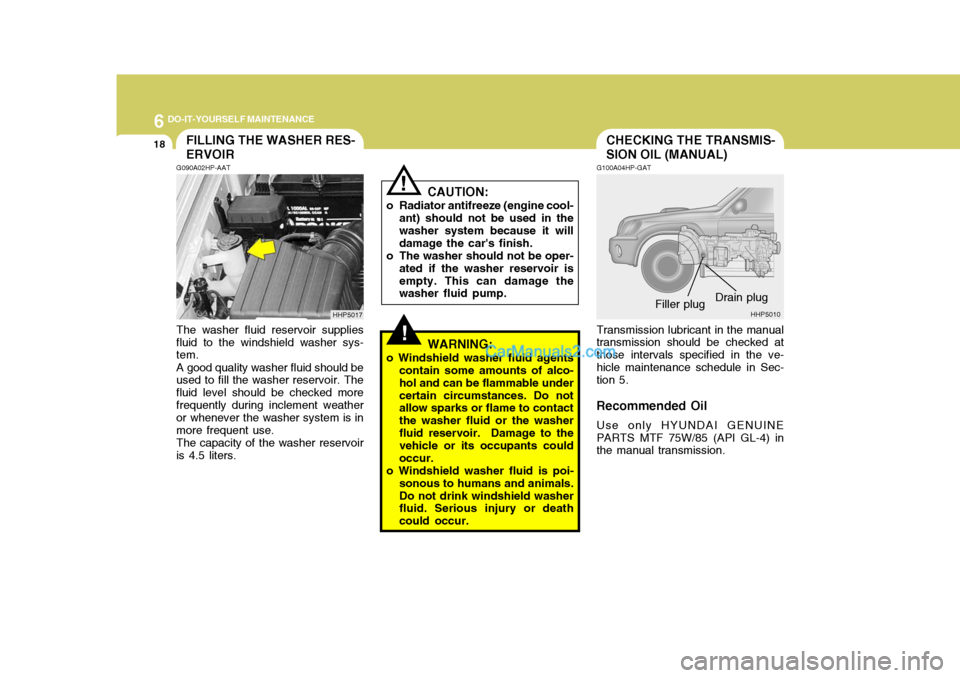
6 DO-IT-YOURSELF MAINTENANCE
18
!
CHECKING THE TRANSMIS- SION OIL (MANUAL)FILLING THE WASHER RES- ERVOIR
CAUTION:
o Radiator antifreeze (engine cool- ant) should not be used in the washer system because it will damage the car's finish.
o The washer should not be oper- ated if the washer reservoir isempty. This can damage the washer fluid pump.
! G100A04HP-GAT Transmission lubricant in the manual transmission should be checked at those intervals specified in the ve-hicle maintenance schedule in Sec- tion 5.
Recommended Oil Use only HYUNDAI GENUINE PARTS MTF 75W/85 (API GL-4) in the manual transmission. Drain plug
G090A02HP-AAT The washer fluid reservoir supplies fluid to the windshield washer sys- tem. A good quality washer fluid should be used to fill the washer reservoir. The fluid level should be checked morefrequently during inclement weather or whenever the washer system is in more frequent use. The capacity of the washer reservoir is 4.5 liters. HHP5017
HHP5010
Filler plug
WARNING:
o Windshield washer fluid agents contain some amounts of alco- hol and can be flammable undercertain circumstances. Do not allow sparks or flame to contact the washer fluid or the washerfluid reservoir. Damage to the vehicle or its occupants could occur.
o Windshield washer fluid is poi- sonous to humans and animals.Do not drink windshield washer fluid. Serious injury or death could occur.
Page 254 of 539
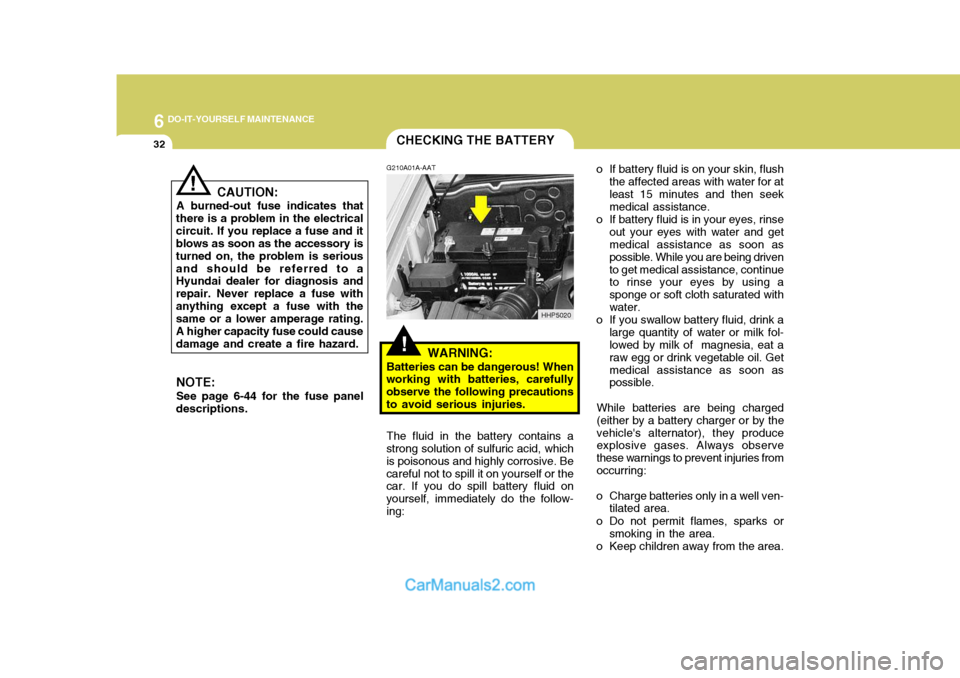
6 DO-IT-YOURSELF MAINTENANCE
32CHECKING THE BATTERY
!
G210A01A-AAT
WARNING:
Batteries can be dangerous! When
working with batteries, carefully observe the following precautionsto avoid serious injuries. o If battery fluid is on your skin, flush
the affected areas with water for atleast 15 minutes and then seek medical assistance.
o If battery fluid is in your eyes, rinse out your eyes with water and getmedical assistance as soon as possible. While you are being drivento get medical assistance, continue to rinse your eyes by using a sponge or soft cloth saturated withwater.
o If you swallow battery fluid, drink a large quantity of water or milk fol- lowed by milk of magnesia, eat a raw egg or drink vegetable oil. Getmedical assistance as soon as possible.
While batteries are being charged (either by a battery charger or by thevehicle's alternator), they produce explosive gases. Always observe these warnings to prevent injuries fromoccurring:
o Charge batteries only in a well ven- tilated area.
o Do not permit flames, sparks or smoking in the area.
o Keep children away from the area.
The fluid in the battery contains a
strong solution of sulfuric acid, whichis poisonous and highly corrosive. Becareful not to spill it on yourself or the car. If you do spill battery fluid on yourself, immediately do the follow-ing:
CAUTION:
A burned-out fuse indicates that
there is a problem in the electricalcircuit. If you replace a fuse and it blows as soon as the accessory is turned on, the problem is seriousand should be referred to a Hyundai dealer for diagnosis and repair. Never replace a fuse withanything except a fuse with the same or a lower amperage rating. A higher capacity fuse could causedamage and create a fire hazard.
NOTE: See page 6-44 for the fuse panel
descriptions.
!
HHP5020
Page 293 of 539
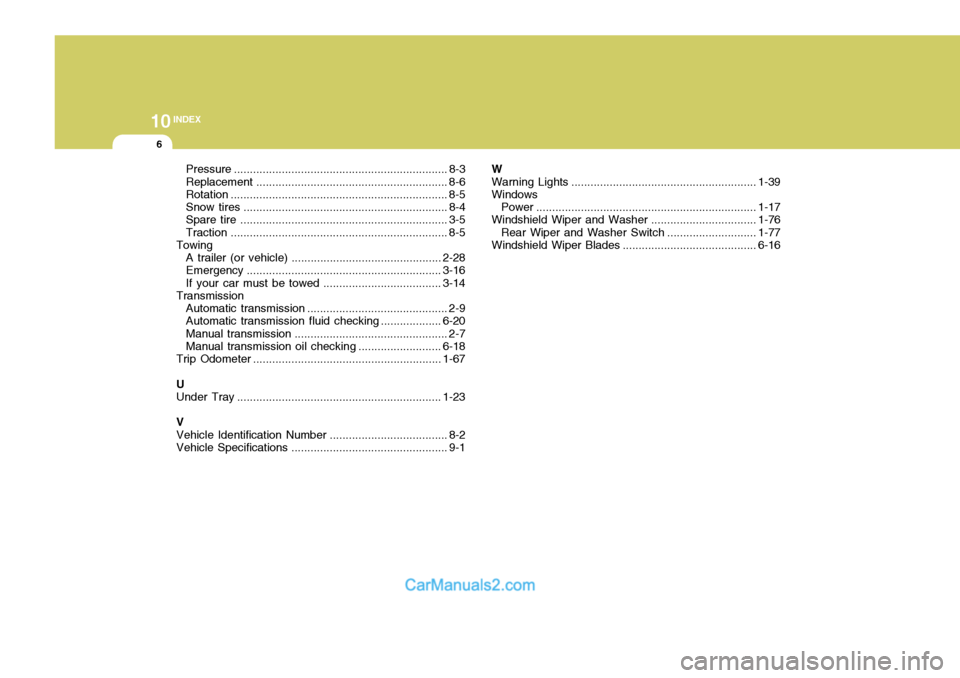
10INDEX
6
Pressure ................................................................... 8-3
Replacement ............................................................ 8-6
Rotation .................................................................... 8-5
Snow tires ................................................................ 8-4
Spare tire ................................................................. 3-5
Traction .................................................................... 8-5
Towing
A trailer (or vehicle) ............................................... 2-28
Emergency ............................................................. 3-16
If your car must be towed .....................................3-14
Transmission
Automatic transmission ............................................ 2-9
Automatic transmission fluid checking ...................6-20
Manual transmission ................................................ 2-7
Manual transmission oil checking .......................... 6-18
Trip Odometer ........................................................... 1-67
U Under T ray ................................................................ 1-23
V Vehicle Identification Number ..................................... 8-2
Vehicle Specifications ................................................. 9-1 WWarning Lights
.......................................................... 1-39
Windows
Power ..................................................................... 1-17
Windshield Wiper and Washer................................. 1-76
Rear Wiper and Washer Switch ............................1-77
Windshield Wiper Blades ..................... ..................... 6-16